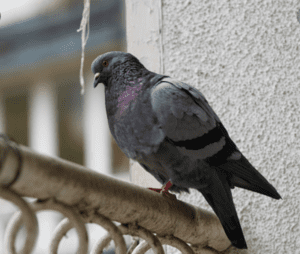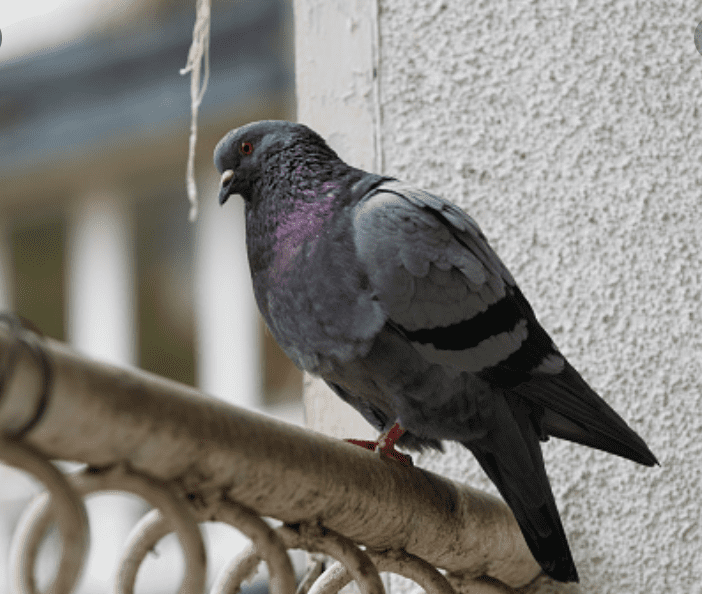For a month the researchers had traversed slender mountain ridges, crossed and re-crossed rivers that roared through canyons cloaked in tropical forest, and endured bloodthirsty mosquitoes and leeches, all in search of something that probably didn’t exist. They had just hours left for searching before they had to leave Fergusson Island, off the east coast of Papua New Guinea. Expedition co-leader Jordan Boersma reckoned their chance of success was less than 1 percent.
Winded from a climb, he plopped down on a lush hillside to catch his breath and began looking through images on the camera traps he’d just collected, not expecting to find anything. “Suddenly I was confronted with this image of what at that time felt like a mythical creature,” says Boersma, a postdoctoral researcher at the Cornell Lab of Ornithology. “It was, without exaggeration, the most surreal moment of my life.”
The camera’s display was tiny, but there was no mistaking the creature it showed: the Black-naped Pheasant-Pigeon, a species that hasn’t been documented by scientists since it was first described in 1882.
“To find something that’s been gone for that long, that you’re thinking is almost extinct, and then to figure out that it’s not extinct, it feels like finding a unicorn or a Bigfoot,” says John C. Mittermeier, director of the lost birds program at American Bird Conservancy and a co-leader of the eight-member expedition. “It’s extraordinarily unusual.”
The stunning late-September rediscovery could not have happened without guidance from local hunters with intimate knowledge of the island’s forests, the researchers say, demonstrating the invaluable role of Indigenous communities in ongoing efforts to relocate species lost to Western science. With its existence confirmed, the Black-naped Pheasant-Pigeon is almost certainly the most endangered bird in New Guinea, which underscores the urgent need to protect its habitat on Fergusson, a rugged, 555-square-mile island that, while largely undeveloped, faces pressure from logging companies.
“This is a huge discovery,” says Bulisa Iova, an expedition member and acting chief curator of the National Museum and Art Gallery in Papua New Guinea. “I have studied birds for many years, and to be part of this team to discover this lost species is a highlight for me.”
The expedition was part of The Search for Lost Birds, a collaboration between BirdLife International, Re:wild, and American Bird Conservancy, which funded the trip. The initiative aims to rediscover more than 150 avian species that haven’t been declared extinct but also have not been seen for at least a decade.
A chicken-size, ground-dwelling pigeon, the Black-naped Pheasant-Pigeon was among around 20 “lost” birds that have not been documented for more than a century. It’s one of four pheasant-pigeon species found around New Guinea, and lives only on Fergusson Island. (Some authorities consider the four varieties to be subspecies.)
Boersma previously searched for the Black-naped Pheasant-Pigeon in 2019 with Jason Gregg, a conservation biologist and Audubon magazine contributor, and local biologist Doka Nason. While the trio did not find the bird on that trip, they did turn up five bird species not previously known to live on Fergusson, which suggested there were significant gaps in what ornithologists knew about the island’s birdlife. And when they spoke with hunters, they heard reports of a bird whose description could only belong to the pheasant-pigeon.
The researchers returned to Fergusson with a larger team in early September, determined to establish trust and work closely with the island’s Indigenous inhabitants to find the species. Day after day they hiked the steep terrain, stopping to interview locals and sleeping in villages or camping in the forest. Hunters in the first few communities were unfamiliar with the large bird the researchers described. But when the team reached the remote western slope of Mt. Kilkerran, they began to meet villagers who recognized the species and referred to it by the name Auwo.
Finally, in the village of Duda Ununa, a hunter named Augustin Gregory told the researchers where he had seen the bird. He described a call that matched those of New Guinea’s other pheasant-pigeon species, which don’t live on Fergusson. And he showed the team an area, on a ridge 3,200 feet above sea level and covered in thick vegetation, where their motion-triggered camera traps were likely to snap the elusive bird. Nason, who grew up in Papua New Guinea near Fergusson, and who Boersma describes as “the most impressive field biologist I’ve worked with anywhere,” selected a spot and set up the camera.

With its vantage limited by dense understory, the site wasn’t a typical one for a camera trap, the scientists say, but the images proved it was the right one. “Unmistakable,” Gregg, an expedition co-leader, says of first seeing the photos. “Tons of mixed emotions. Everything from solemn relief of burden to fist-pumping and screaming.”
Only days later, with time to scroll through everything the traps had captured, did the team realize that another camera had recorded video of a pheasant-pigeon. Given that the images were taken several kilometers apart, they almost certainly show two individuals.
Now that scientists know the Black-naped Pheasant-Pigeon still exists, the focus becomes keeping the critically endangered species from going extinct. As with other once-lost birds, its population is likely very small and seriously imperiled. Logging by international corporations appears to be a growing threat, and introduced predators such as feral cats could take a toll on the pheasant-pigeon as they have on other endemic island birds, according to Gregg. Sustaining the long-lost species will require learning more about its behavior and population status and launching conservation projects to protect its habitat, all with Fergusson Island residents in a leading role.
“Knowing what we know about bird extinction and conservation on islands around the world, we can expect that the combination of logging and introduced species, especially introduced mammals, is going to have an impact,” Gregg says. “This land and the fate of any conservation work that happens on this land is completely up to the communities that live there and own the land.”
Beyond Fergusson Island’s luxuriant forests, the rediscovery of the Black-naped Pheasant-Pigeon raises hopes that future expeditions will turn up other species lost to science but known all along to local experts. “The way this was always going to work is that we just really lean into local knowledge and put our faith in our local partners,” Boersma says. “That’s what delivered this incredible moment for us.”
Pigeon Patrol Products & Services is the leading manufacturer and distributor or bird deterrent (control) products in Canada. Pigeon Patrol products have solved pest bird problems in industrial, commercial, and residential settings since 2000, by using safe and humane bird
deterrents with only bird and animal friendly solutions. At Pigeon Patrol, we manufacture and offer a variety of bird deterrents, ranging from Ultra-flex Bird Spikes with UV protection, Bird Netting, 4-S Bird Gel and the best Ultrasonic and audible sound devices on the market today.
Voted Best Canadian wholesaler for Bird Deterrent products ten years in a row.
Contact us at 1 877-4-NO-BIRD,(604) 585-9279 or visit our website at www.pigeonpatrol.ca
Pigeon/Pigeon Patrol / Pigeons Roosing / Vancouver Pigeon Control / Bird Spikes / Bird Control / Bird Deterrent / PIgeon Deterrent / Surrey Pigeon Control / Pest / Seagull deterrent / Vancouver Pigeon Blog / Birds Inside Home / Pigeons in the cities / Ice Pigeons / What to do about pigeons / sparrows, Damage by Sparrows, How to Keep Raccoons Away, Why Are Raccoons Considered Pests / De-fence / Pigeon Nesting / Bird Droppings / Pigeon Dropping / woodpecker control / Professional Bird Control Company / Keep The Birds Away / Birds/rats/seagull/pigeon/woodpecker/dove/sparrow/pidgeon control/pidgeon problem/pidgeon control/flying rats/pigeon problems/ bird netting/bird gel/bird spray/bird nails/bird guard

